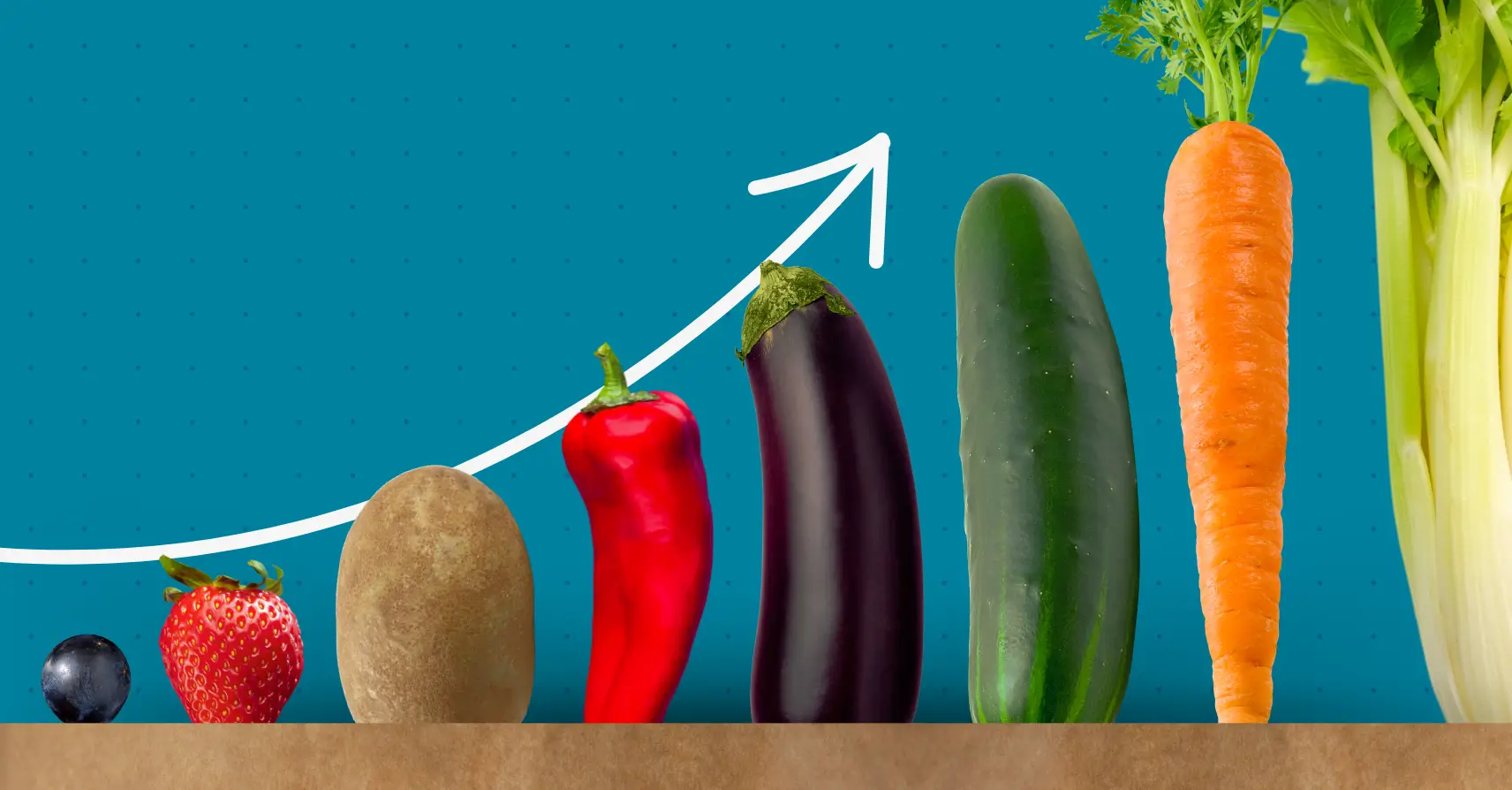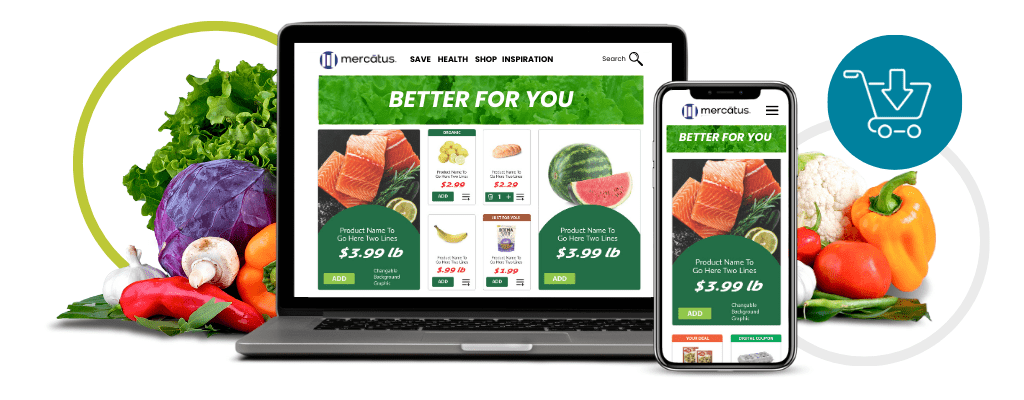
5 Online Grocery Store Marketing Strategies to Retain Customers and Boost Revenue
This article was originally published on October 18, 2022. It was updated on December 17, 2024.
For decades, print circulars have been the gold standard in supermarket advertising.
These flyers, full of promotions and discounts, are delivered weekly to nearby residents with the hope that they’ll attract customers and drive foot traffic to local grocery stores.
As supermarket shoppers increasingly shift to grocery eCommerce and their preference for a more customized customer experience becomes more established, the broad spectrum approach of print circulars has come into question.
And while a print vs. digital debate might prompt some to think of circulars as outdated, the principle behind them—informing potential, nearby customers of relevant offers—remains as important as ever.
It’s just that now, thanks to innovations in grocery technology, grocery retailers are able to reach customers on a more personal level, through shopper segmentation capabilities that extend far beyond merely their zip code. These advancements in personalization and targeting offer a far more effective, less expensive, and more trackable means of reaching a target audience than the traditional print circular.

This is good news for grocers, who need a cost-effective way to compete with larger retailers gaining market share. Big retailers like Walmart not only offer customers increased value through lower price points, but can also afford expensive advertising and marketing campaigns that provide repeated exposure across multiple touch points.
To keep up, regional grocers need effective and efficient advertising that attracts new customers to their grocery eCommerce platform, retains regular grocery shoppers, and also provides additional revenue streams.
In this article, we’ll identify five advertising tactics that leverage technology to do exactly that.
5 Online Grocery Store Marketing Tactics To Reach Modern Consumers and Boost Profits
1. Invest in Retail Media Opportunities
We’ve already identified the sizeable advantage that big retailers have when it comes to advertising budgets. This advantage extends into retail media efforts, as well, allowing other major retailers like Walmart to generate significant additional revenue by monetizing both the in-person and online shopping experience for consumer packaged goods (CPG) advertising.
Retail media networks—essentially, ad platforms owned and operated by retailers—allow brands to pay for ad placements within a retailer’s ecosystem, targeting online shoppers at the most opportune moments.
This approach not only increases online grocery sales but also strengthens the retailer’s relationship with both customers and advertisers.
Opportunities for Regional Grocers in Retail Media
While Walmart and other national retailers have the advantage of scale, regional grocers are uniquely positioned to offer something equally valuable: a highly targeted, loyal audience.
Regional retail media networks provide advertisers with access to a more specific, localized audience that larger networks may struggle to reach. This targeted approach can lead to more personalized campaigns that resonate strongly with shoppers, driving higher engagement and loyalty.
Why Regional Retail Media Networks Matter
Regional grocers can leverage retail media to create new revenue streams by monetizing their loyal customer base, particularly through their grocery eCommerce platforms and mobile apps.
Nearly half of North American marketers measure their advertising performance based on reaching a targeted audience, making the hyper-local focus of regional grocers an appealing alternative for brands looking to connect more meaningfully with consumers.
2. Implement a Sponsored Product Sampling Program
Like the print circular, product sampling has always been a cornerstone of supermarket advertising, providing shoppers with the opportunity to try before they buy.
Now, with advancements in digital media, product sampling—as a specific form of retail media—has become a powerful omnichannel opportunity for online grocery stores, CPG brands, and shoppers alike.
Sponsored product sampling allows grocers to offer targeted samples of new or featured products directly through their grocery eCommerce platforms, mobile apps, or in-store shopping environments, creating seamless and engaging brand experiences that drive customer loyalty and boost online grocery sales—all while enhancing partnerships with CPG brands.
Addressing Key Challenges for Regional Grocers
Despite its clear benefits, converting product sampling into a streamlined retail media solution has historically been challenging for regional grocers due to logistical complexities, targeting difficulties, and measuring the effectiveness of campaigns.
However, recent advancements in technology have begun to address these hurdles, making it easier than ever for grocery retailers to capitalize on sponsored product sampling.
It’s truly a win-win-win situation.
For an Online Grocery Store:
- Sponsored product sampling boosts customer engagement, generates additional revenue through online grocery sales and sponsored brand fees, and provides actionable insights into customer preferences to refine marketing strategies.
For CPG Brands:
- It enables precise targeting of relevant audiences, delivers measurable ROI through detailed performance metrics, and enhances product visibility, leading to higher conversion rates and customer acquisition.
For Customers:
- Offers a personalized and convenient way to discover new products, enhancing the online grocery shopping experience with relevant samples that encourage repeat customers to explore new groceries online and build brand loyalty.
This win-win-win scenario is exactly what retailers get with Mercatus’s Sponsored Product Sampling program. This solution—created in collaboration with Swish Brand Experiences— allows retailers to transform their approach to product sampling, not only making it a powerful tool in their advertising arsenal, but also a means of increasing profitability.
3. Use Personalized Messaging to Increase Online Grocery Shopping
Retail media opportunities like sponsored product sampling rely heavily on utilizing shopping data to reach online grocery store customers with the most relevant offers.
This level of personalization isn’t limited to sponsored products. Today’s technology allows grocery retailers to send millions of personalized product recommendations each week based on online grocery shopping data, delivering the right message to the right customer at the right time.
The personalization process is driven by first-party data, which can be collected directly from online grocery shoppers through their past purchases, browsing history, and interactions with previous marketing campaigns.
This information on individual grocery shoppers is invaluable for customer segmentation that can be used to create highly customized advertising and marketing campaigns that resonate with individual needs and preferences—while also being timed to purchase cycles.
Consolidating First-Party Data for Automated Online Grocery Store Marketing Campaigns
To maximize the impact of personalized messaging, an online grocery store needs to consolidate data from various sources—point-of-sale systems, loyalty programs, and grocery eCommerce platforms—into a unified customer profile.
This comprehensive view helps a regional grocery store understand consumer behaviors across all channels, allowing for a seamless, consistent customer experience both online and in-store. This consolidated customer data is used to automate highly personalized marketing campaigns using advanced algorithms and machine learning.
These systems analyze online shopping data including past purchases to predict customer needs, delivering targeted offers at the perfect time. For example, if a customer buys a particular brand of jam monthly, an automated offer can be sent just before their next purchase cycle. This approach boosts engagement, enhances the online grocery shopping experience, and drives online grocery sales by meeting the specific needs of loyal customers in real-time.
When retailers imagine a way of accomplishing all of these things, what they’re envisioning is the personalization solution from Mercatus.
Our solution allows a grocery business to market a truly personalized shopping experience. Its automation capabilities, aligned to individual customer journey mapping, provide grocers with the ability to send millions of personalized product recommendations weekly.
4. Reach Customers Across Multiple Channels
When we talk about omnichannel advertising or marketing in grocery retail, the focus often centers on the importance of creating a unified experience both in-store and online. And that’s essential.
Today’s consumers expect a seamless shopping journey whether they’re shopping at an online store or at a brick-and-mortar location. However, “online” is not just one channel—it’s a collection of digital touch points where customers engage with a grocery store in various ways.
To effectively connect with online grocery shoppers, grocers must be able to reach them across multiple digital channels, including email, SMS, mobile notifications, and in-app messaging.
The Power of Multi-channel Engagement
Consumers interact with digital channels differently based on their preferences, shopping habits, and the specific context of their grocery shopping journey. Some may respond well to a personalized email detailing weekly promotions, while others might prefer receiving real-time SMS updates about flash sales or special offers.
The ability to reach customers with relevant, personalized offers across multiple channels is once again rooted in the effective use of customer data.
By understanding and utilizing the preferred communication channels of their shoppers, grocers can significantly enhance engagement and drive higher conversion rates with their personalized promotions
Leveraging Technology for Multi-channel Delivery
Not only does advanced technology empower a grocery store to deliver highly personalized content, it also allows them to strategically deploy it through the most appropriate platforms, creating a consistent and engaging grocery shopping experience across all touch points.
Ultimately, reaching customers across multiple channels isn’t just about expanding presence; it’s about meeting customers where they are and delivering a personalized, convenient, and consistent shopping experience that increases in-store and online grocery sales.
That’s the type of supermarket advertising that Mercatus makes possible.
Mercatus’s eMarketing automation uses proprietary algorithms and machine learning to tailor content based on customer behaviors and purchasing patterns.
Its Automated Journey Mapping, Programmatic Targeting and Multi-Channel Delivery tools work together to build complex customer profiles and deploy strategic campaigns that consistently engage customers through email, SMS/text, mobile push, and integrated grocery eCommerce platforms.
5. Promote Grocery Stores Through Loyalty Programs
The best loyalty programs tie together several of the strategies outlined in this article, combining traditional supermarket advertising methods with digital solutions to create a truly unified customer journey across in-store and online experiences.
However, the loyalty programs that grocery stores have traditionally used to advertise generic discounts through impersonal messaging are simply not enough to engage modern consumers. To enhance the lifetime value of customers, grocers must develop their loyalty strategies through advanced personalization technology.
Connecting Loyalty Programs to Advertising Solutions
Loyalty programs, when powered by advanced personalization and data analytics, act as a natural extension of supermarket advertising.
By integrating personalized offers and rewards into your marketing campaigns, you can enhance engagement, improve targeting, and create a consistent message across all touch points—for your eCommerce store and brick-and-mortar location.
This approach not only boosts grocery eCommerce sales but also turns every interaction into an opportunity to build deeper, more meaningful connections with your customers.
The Goal of Loyalty Programs Should be Customer Loyalty
That focus on customer lifetime value over one more transaction acknowledges the importance of customer retention to the grocery industry, where it’s estimated to cost as many 3.5 new customers to replace the value of one long-term customer leaving.
Loyalty programs are more than just a tool for rewarding purchases—they are a powerful advertising tool that engages customers on a personal level, adding value to the online grocery shopping experience and keeping customers loyal to your brand.
Enhance Your Supermarket Advertising with Mercatus
Regaining your market share from big retailers is no easy task.
It’s hard enough to compete with their aggressive pricing strategies, let alone the extensive advertising budgets they wield in an attempt to win over your regular customers. For regional grocers, the pressure to find cost-effective and impactful ways to reach and retain customers has never been greater.
What a grocery business needs is a tailored solution that maximizes the impact of their marketing dollars.
Mercatus offers a comprehensive suite of grocery eCommerce tools specifically developed for regional grocers to help them find a competitive edge in today’s market.
By leveraging Mercatus’s retail media solution, personalized product sampling, and advanced personalization technologies, grocers can enhance their marketing efforts, strengthen CPG partnerships, and connect with customers on a deeper, more personalized level.
Reach out to our sales team today to find the advertising solution your online grocery business needs to not only increase sales, but enhance long-term customer retention and provide new paths to profitability in grocery eCommerce.
 Newsroom
Newsroom
